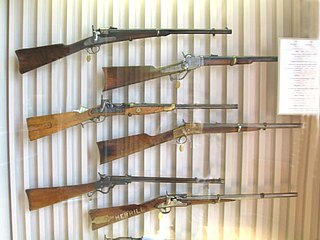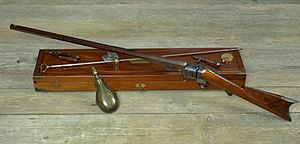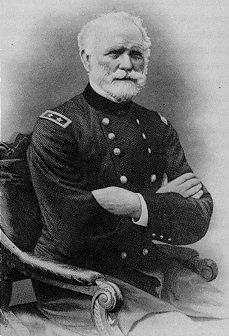
A revolver is a repeating handgun that has at least one barrel and uses a revolving cylinder containing multiple chambers for firing. Before firing a round, cocking the hammer partially rotates the cylinder, indexing one of the cylinder chambers into alignment with the barrel, allowing the bullet to be fired through the bore. The hammer cocking can be achieved by either the user manually pulling the hammer back, via internal linkage relaying a rearward movement of the trigger, or both. By sequentially rotating through each chamber, the revolver allows the user to fire multiple times until having to reload the gun, unlike older single-shot firearms that had to be reloaded after each shot.

Samuel Colt was an American inventor, industrialist, and businessman who established Colt's Patent Fire-Arms Manufacturing Company and made the mass production of revolvers commercially viable.

Colt's Manufacturing Company, LLC is an American firearms manufacturer, founded in 1855 by Samuel Colt and is now a subsidiary of Czech holding company Colt CZ Group. It is the successor corporation to Colt's earlier firearms-making efforts, which started in 1836. Colt is known for the engineering, production, and marketing of firearms, most especially between the 1850s and World War I, when it was a dominating force in its industry and a seminal influence on manufacturing technology. Colt's earliest designs played a major role in the popularization of the revolver and the shift away from earlier single-shot pistols. Although Samuel Colt did not invent the revolver concept, his designs resulted in the first very successful ones.

The pepper-box revolver or simply pepperbox is a multiple-barrel firearm, mostly in the form of a handgun, that has three or more gun barrels in a coaxially revolving mechanism. Each barrel holds a single shot, and the shooter can manually rotate the whole barrel assembly to sequentially index each barrel into alignment with the lock or hammer, similar to rotation of a revolver's cylinder.
A repeating rifle is a single-barreled rifle capable of repeated discharges between each ammunition reloads. This is typically achieved by having multiple cartridges stored in a magazine and then fed individually into the chamber by a reciprocating bolt, via either a manual or automatic action mechanism, while the act of chambering the round typically also recocks the hammer/striker for the following shot. In common usage, the term "repeating rifle" most often refers specifically to manual repeating rifles, as opposed to self-loading rifles, which use the recoil and/or blowback of the previous shot to cycle the action and load the next round, even though all self-loading firearms are technically a subcategory of repeating firearms.

Ethan Allen was a major American arms maker from Massachusetts. He is unrelated to the revolutionary Ethan Allen. His first firearm, the "Pocket rifle" was developed in 1836, and his first patent was granted in 1837.
The Massachusetts Arms Company, of Chicopee Falls, Massachusetts was a manufacturer of firearms and firearm-related products from about 1849 into the early 20th century.

The Colt Model 1848 Percussion Army Revolver is a .44 caliber revolver designed by Samuel Colt for the U.S. Army's Regiment of Mounted Rifles. The revolver was also issued to the Army's "Dragoon" Regiments. This revolver was designed as a solution to numerous problems encountered with the Colt Walker. Although it was introduced after the Mexican–American War, it became popular among civilians during the 1850s and 1860s, and was also used during the American Civil War.

The model 1805 U.S. Marshal "Harper's Ferry" flintlock pistol, manufactured at the Harpers Ferry Armory in Virginia, was the first pistol manufactured by an American national armory. It was the standard handgun of the US dragoons during the War of 1812.

The Colt New Model Revolving rifles were early repeating rifles produced by the Colt's Manufacturing Company from 1855 until 1864. The design was essentially similar to revolver type pistols, with a rotating cylinder that held five or six rounds in a variety of calibers from .36 to .64 inches. They were mainly based upon the Colt Model 1855 Sidehammer Pocket Revolver developed by Elisha K. Root. Colt revolving pistols and rifles were attractive mainly because of their high rate of fire. They were used to a limited extent on the Pony Express, and made a brief appearance in the American Civil War. However, the rifles were generally disliked by soldiers, and were ultimately discontinued due to serious design flaws.

The Colt Paterson revolver was the first commercial repeating firearm employing a revolving cylinder with multiple chambers aligned with a single, stationary barrel. Its design was patented by Samuel Colt on February 25, 1836, in the United States, England and France, and it derived its name from being produced in Paterson, New Jersey. Initially this 5 shot revolver was produced in .28 caliber, with a .36 caliber model following a year later. As originally designed and produced, no loading lever was included with the revolver; a user had to partially disassemble the revolver to re-load it. Starting in 1839, however, a reloading lever and a capping window were incorporated into the design, allowing reloading without disassembly. This loading lever and capping window design change was also incorporated after the fact into most Colt Paterson revolvers that had been produced from 1836 until 1839. Unlike later revolvers, a folding trigger was incorporated into the Colt Paterson. The trigger became visible only upon cocking the hammer.

The Colt Walker, sometimes known as the Walker Colt, is a single-action revolver with a revolving cylinder holding six charges of black powder behind six bullets. It was designed in 1846 by American firearms inventor Samuel Colt to the specifications of Captain Samuel Hamilton Walker.
Daniel Leavitt was an early American inventor who, with his partner Edwin Wesson, patented the first revolver after Samuel Colt's, and subsequently manufactured one of the first American revolving pistols. The innovative design was manufactured only briefly before a patent suit by Colt forced the company to stop producing the Leavitt & Wesson Dragoon revolver. But Leavitt's early patents, and those of his partner Wesson, stoked competition and helped drive the technological and manufacturing boom that produced the modern firearms industry.

The Colt Lightning Carbine or Colt Lightning Rifle was a slide-action (pump-action) rifle manufactured by Colt from 1884 until 1904 and was originally chambered in .44-40 caliber. Colt eventually made the Lightning Rifle in three different frame sizes, to accommodate a wide range of cartridges, from .22 Short caliber and .38-40 to .50-95 Express. Its profile resembles the pump-action rimfire rifles made by the Winchester Repeating Arms Company and Remington Arms. The Lightning saw use as a sporting arm in America and was adopted for use by the San Francisco Police Department, but was never as popular or as reliable as the various lever-action rifles of its day.

The Merrill carbine was a breechloader firearm designed by Baltimore, Maryland gunsmith and inventor James H. Merrill. It was one of several firearms either manufactured or altered by Merrill in fulfillment of contracts with the Union government during the U.S. Civil War.

Christopher Miner Spencer was an American inventor, from Manchester, Connecticut, who invented the Spencer repeating rifle, one of the earliest models of lever-action rifle, a steam powered "horseless carriage", and several other inventions. He developed the first fully automatic turret lathe, which in its small- to medium-sized form is also known as a screw machine.

The Colt Model 1855 Sidehammer, also known as the Colt Root Revolver after engineer Elisha K. Root (1808–1865), was a cap & ball single-action pocket revolver used during the American Civil War and made by the Colt's Patent Fire Arms Manufacturing Company

The Colt-Burgess rifle, also known as the 1883 Burgess rifle or simply the Burgess rifle, is a lever-action repeating rifle produced by Colt's Patent Firearms Manufacturing Company between 1883 and 1885. The Burgess rifle was Colt's only entrance into the lever-action rifle market, produced to compete with Winchester Repeating Arms Company's line of popular rifles. The 1883 Burgess rifle was designed and patented by Andrew Burgess, an American firearms designer and photographer, who sold the design to Colt.
The Colt Model 1839 Carbine is an early percussion revolving smoothbore carbine manufactured by the Patent Arms Manufacturing Company between 1838 and 1841. Produced alongside the Colt Second Model Ring Lever rifle, the Model 1839 was the most popular longarm of the Patent Arms period. The Model 1839 Carbine is differentiated from Colt's Ring Lever rifles by the lack of a cocking ring lever and the presence of an external hammer, which, when manually cocked, would rotate the six-shot cylinder to the next position. Approximately 950 Model 1839 Carbines were manufactured, and an additional shotgun variant, the Model 1839 Shotgun, was produced from 1839 to 1841 with approximately 225 manufactured. Though the United States Navy and Texas Navy purchased a number of Model 1839 Carbines, sales suffered due to the gun's high price and quality control issues.

A repeating firearm, or repeater, is any firearm that is capable of being fired repeatedly before having to manually reload new ammunition into the weapon.


















